Quickstart
This guide will help you get started with VegasAfterglow quickly. We’ll cover basic installation, setting up a simple model, and running your first afterglow parameter estimation.
Installation
The easiest way to install VegasAfterglow is via pip:
pip install VegasAfterglow
For more detailed installation instructions, see the Installation page.
Basic Usage
VegasAfterglow is designed to efficiently model gamma-ray burst (GRB) afterglows and perform Markov Chain Monte Carlo (MCMC) parameter estimation.
Direct Model Calculation
Before diving into MCMC parameter estimation, you can directly use VegasAfterglow to generate light curves and spectra from a specific model. Let’s start by importing the necessary modules:
import numpy as np
import matplotlib.pyplot as plt
from VegasAfterglow import ISM, TophatJet, Observer, Radiation, Model
Then, let’s set up the physical components of our afterglow model, including the environment, jet, observer, and radiation parameters:
# 1. Define the circumburst environment (constant density ISM)
medium = ISM(n_ism=1) # in cgs unit
# 2. Configure the jet structure (top-hat with opening angle, energy, and Lorentz factor)
jet = TophatJet(theta_c=0.1, E_iso=1e52, Gamma0=300) # in cgs unit
# 3. Set observer parameters (distance, redshift, viewing angle)
obs = Observer(lumi_dist=1e26, z=0.1, theta_obs=0) # in cgs unit
# 4. Define radiation microphysics parameters
rad = Radiation(eps_e=1e-1, eps_B=1e-3, p=2.3)
# 5. Combine all components into a complete afterglow model
model = Model(jet=jet, medium=medium, observer=obs, fwd_rad=rad)
Light Curve Calculation
Now, let’s compute and plot multi-wavelength light curves to see how the afterglow evolves over time:
# 1. Create logarithmic time array from 10² to 10⁸ seconds (100s to ~3yrs)
times = np.logspace(2, 8, 200)
# 2. Define observing frequencies (radio, optical, X-ray bands in Hz)
bands = np.array([1e9, 1e14, 1e17])
# 3. Calculate the afterglow emission at each time and frequency
results = model.flux_density_grid(times, bands)
# 4. Visualize the multi-wavelength light curves
plt.figure(figsize=(4.8, 3.6), dpi=200)
# 5. Plot each frequency band
for i, nu in enumerate(bands):
exp = int(np.floor(np.log10(nu)))
base = nu / 10**exp
plt.loglog(times, results.total[i,:], label=fr'${base:.1f} \times 10^{{{exp}}}$ Hz')
# 6. Add annotations for important transitions
def add_note(plt):
plt.annotate('jet break',xy=(3e4, 1e-26), xytext=(3e3, 5e-28), arrowprops=dict(arrowstyle='->'))
plt.annotate(r'$\nu_m=\nu_a$',xy=(6e5, 3e-25), xytext=(7.5e4, 5e-24), arrowprops=dict(arrowstyle='->'))
plt.annotate(r'$\nu=\nu_a$',xy=(1.5e6, 4e-25), xytext=(7.5e5, 5e-24), arrowprops=dict(arrowstyle='->'))
add_note(plt)
plt.xlabel('Time (s)')
plt.ylabel('Flux Density (erg/cm²/s/Hz)')
plt.legend()
plt.title('Light Curves')
plt.tight_layout()
plt.savefig('assets/quick-lc.png', dpi=300)
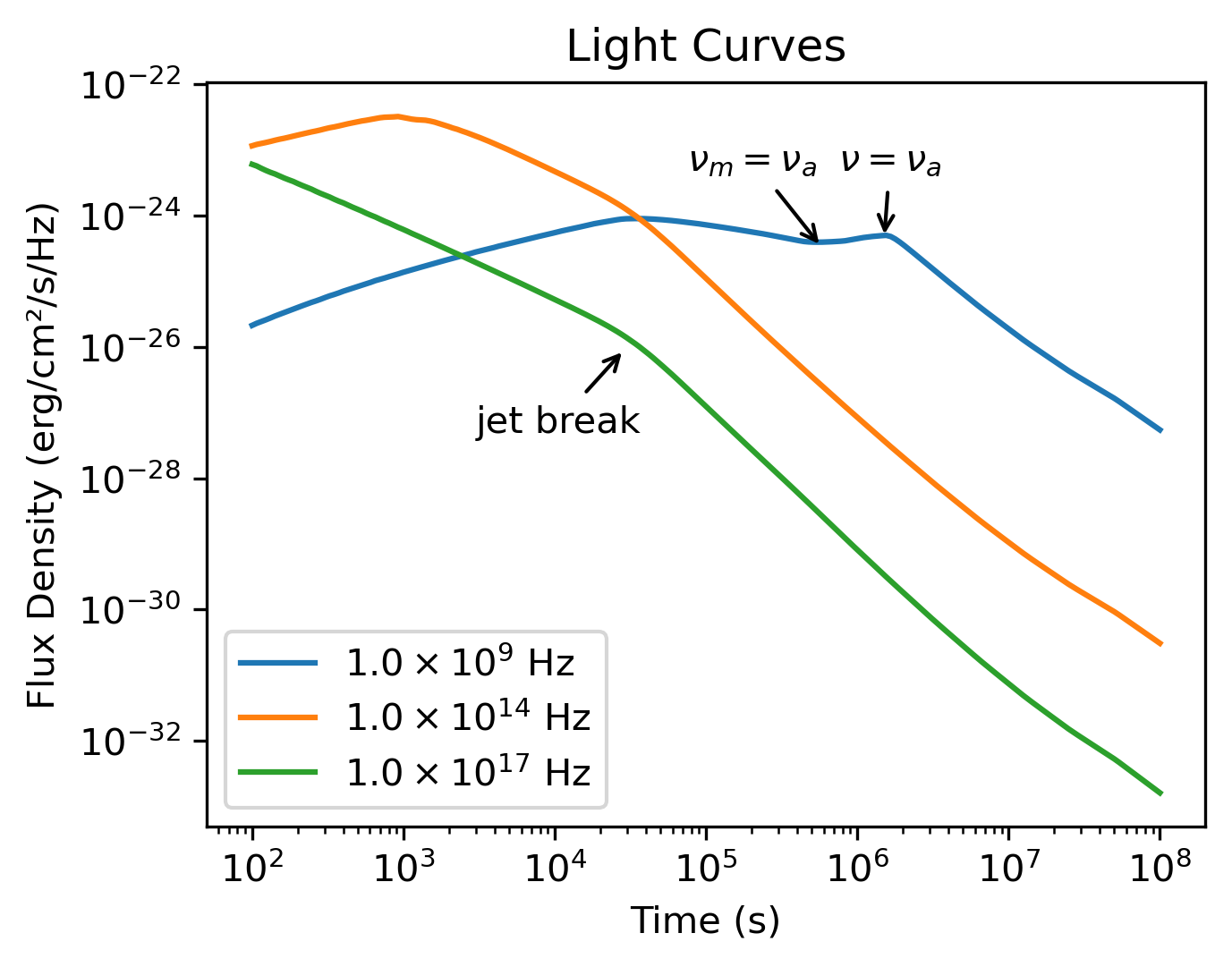
Running the light curve script will produce this figure showing the afterglow evolution across different frequencies.
Spectral Analysis
We can also examine how the broadband spectrum evolves at different times after the burst:
# 1. Define broad frequency range (10⁵ to 10²² Hz)
frequencies = np.logspace(5, 22, 200)
# 2. Select specific time epochs for spectral snapshots
epochs = np.array([1e2, 1e3, 1e4, 1e5, 1e6, 1e7, 1e8])
# 3. Calculate spectra at each epoch
results = model.flux_density_grid(epochs, frequencies)
# 4. Plot broadband spectra at each epoch
plt.figure(figsize=(4.8, 3.6),dpi=200)
colors = plt.cm.viridis(np.linspace(0,1,len(epochs)))
for i, t in enumerate(epochs):
exp = int(np.floor(np.log10(t)))
base = t / 10**exp
plt.loglog(frequencies, results.total[:,i], color=colors[i], label=fr'${base:.1f} \times 10^{{{exp}}}$ s')
# 5. Add vertical lines marking the bands from the light curve plot
for i, band in enumerate(bands):
plt.axvline(band, ls='--', color=f'C{i}')
plt.xlabel('Frequency (Hz)')
plt.ylabel('Flux Density (erg/cm²/s/Hz)')
plt.legend(ncol=2)
plt.title('Synchrotron Spectra')
plt.tight_layout()
plt.savefig('assets/quick-spec.png', dpi=300)
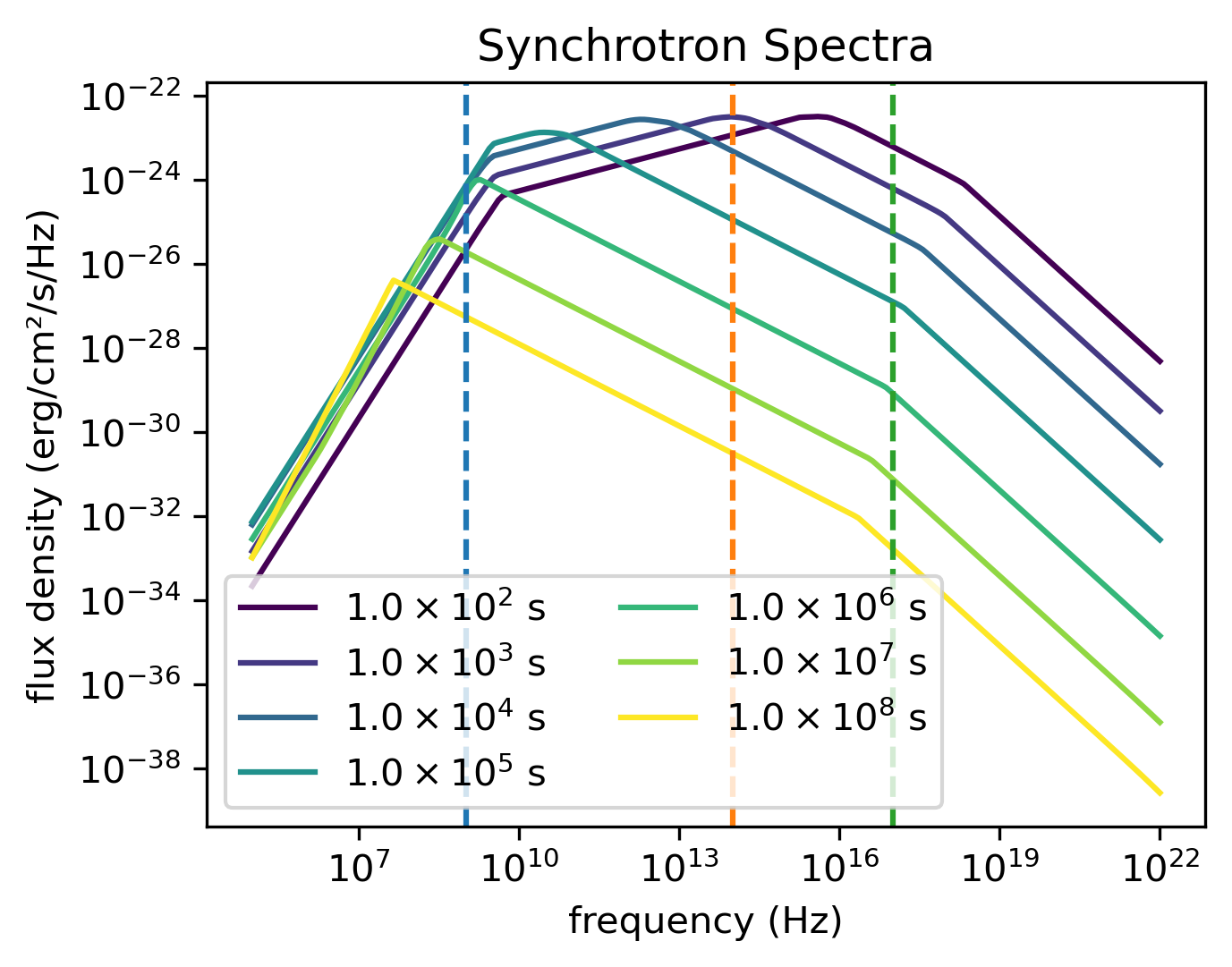
The spectral analysis code will generate this visualization showing spectra at different times, with vertical lines indicating the frequencies calculated in the light curve example.
Internal Quantities Evolution
VegasAfterglow provides comprehensive access to internal simulation quantities, allowing you to analyze the temporal evolution of physical parameters across different reference frames. This advanced feature enables detailed investigation of shock dynamics, microphysical parameters, and relativistic effects throughout the afterglow evolution.
Model Setup for Internal Analysis
Similar to the light curve generation, let’s set up the physical components of our afterglow model with additional resolution parameters for detailed internal tracking:
import numpy as np
import matplotlib.pyplot as plt
from VegasAfterglow import ISM, TophatJet, Observer, Radiation, Model
medium = ISM(n_ism=1)
jet = TophatJet(theta_c=0.3, E_iso=1e52, Gamma0=100)
obs = Observer(lumi_dist=1e26, z=0.1, theta_obs=0.)
rad = Radiation(eps_e=1e-1, eps_B=1e-3, p=2.3)
# Include resolution parameters for detailed internal tracking
model = Model(jet=jet, medium=medium, observer=obs, fwd_rad=rad, resolutions=(0.3,1,10))
Accessing Simulation Quantities
Now, let’s access the internal simulation quantities using the details method:
# Get the simulation details over a time range
details = model.details(t_min=1e0, t_max=1e8)
# Print the available attributes
print("Simulation details attributes:", dir(details))
print("Forward shock attributes:", dir(details.fwd))
You will get a SimulationDetails object with the following structure:
Main grid coordinates:
details.phi: 1D numpy array of azimuthal angles in radiansdetails.theta: 1D numpy array of polar angles in radiansdetails.t_src: 3D numpy array of source frame times on coordinate (phi_i, theta_j, t_k) grid in seconds
Forward shock details (accessed via ``details.fwd``):
details.fwd.t_comv: 3D numpy array of comoving times for the forward shock in secondsdetails.fwd.t_obs: 3D numpy array of observer times for the forward shock in secondsdetails.fwd.Gamma: 3D numpy array of downstream Lorentz factors for the forward shockdetails.fwd.Gamma_th: 3D numpy array of thermal Lorentz factors for the forward shockdetails.fwd.r: 3D numpy array of lab frame radii in centimetersdetails.fwd.B_comv: 3D numpy array of downstream comoving magnetic field strengths for the forward shock in Gaussdetails.fwd.theta: 3D numpy array of polar angles for the forward shock in radiansdetails.fwd.N_p: 3D numpy array of downstream shocked proton number per solid angle for the forward shockdetails.fwd.N_e: 3D numpy array of downstream synchrotron electron number per solid angle for the forward shockdetails.fwd.gamma_a: 3D numpy array of comoving frame self-absorption Lorentz factors for the forward shockdetails.fwd.gamma_m: 3D numpy array of comoving frame injection Lorentz factors for the forward shockdetails.fwd.gamma_c: 3D numpy array of comoving frame cooling Lorentz factors for the forward shockdetails.fwd.gamma_M: 3D numpy array of comoving frame maximum Lorentz factors for the forward shockdetails.fwd.nu_a: 3D numpy array of comoving frame self-absorption frequencies for the forward shock in Hzdetails.fwd.nu_m: 3D numpy array of comoving frame injection frequencies for the forward shock in Hzdetails.fwd.nu_c: 3D numpy array of comoving frame cooling frequencies for the forward shock in Hzdetails.fwd.nu_M: 3D numpy array of comoving frame maximum frequencies for the forward shock in Hzdetails.fwd.I_nu_max: 3D numpy array of comoving frame synchrotron maximum specific intensities for the forward shock in erg/cm²/s/Hzdetails.fwd.Doppler: 3D numpy array of Doppler factors for the forward shock
Reverse shock details (accessed via ``details.rvs``, if reverse shock is enabled):
Similar attributes as forward shock but for the reverse shock component
Multi-Parameter Evolution Visualization
To analyze the temporal evolution of physical parameters across different reference frames, we can visualize how key quantities evolve in the source frame, comoving frame, and observer frame. This code creates a comprehensive multi-panel figure displaying the temporal evolution of fundamental shock parameters across all three reference frames:
attrs =['Gamma', 'B_comv', 'N_p','r','N_e','I_nu_max']
ylabels = [r'$\Gamma$', r'$B^\prime$ [G]', r'$N_p$', r'$r$ [cm]', r'$N_e$', r'$I_{\nu, \rm max}^\prime$ [erg/s/Hz]']
frames = ['t_src', 't_comv', 't_obs']
titles = ['source frame', 'comoving frame', 'observer frame']
colors = ['C0', 'C1', 'C2']
xlabels = [r'$t_{\rm src}$ [s]', r'$t^\prime$ [s]', r'$t_{\rm obs}$ [s]']
plt.figure(figsize= (4.2*len(frames), 3*len(attrs)))
#plot the evolution of various parameters for phi = 0 and theta = 0 (so the first two indexes are 0)
for i, frame in enumerate(frames):
for j, attr in enumerate(attrs):
plt.subplot(len(attrs), len(frames) , j * len(frames) + i + 1)
if j == 0:
plt.title(titles[i])
value = getattr(details.fwd, attr)
if frame == 't_src':
t = getattr(details, frame)
else:
t = getattr(details.fwd, frame)
plt.loglog(t[0, 0, :], value[0, 0, :], color='k',lw=2.5)
plt.loglog(t[0, 0, :], value[0, 0, :], color=colors[i])
plt.xlabel(xlabels[i])
plt.ylabel(ylabels[j])
plt.tight_layout()
plt.savefig('shock_quantities.png', dpi=300,bbox_inches='tight')
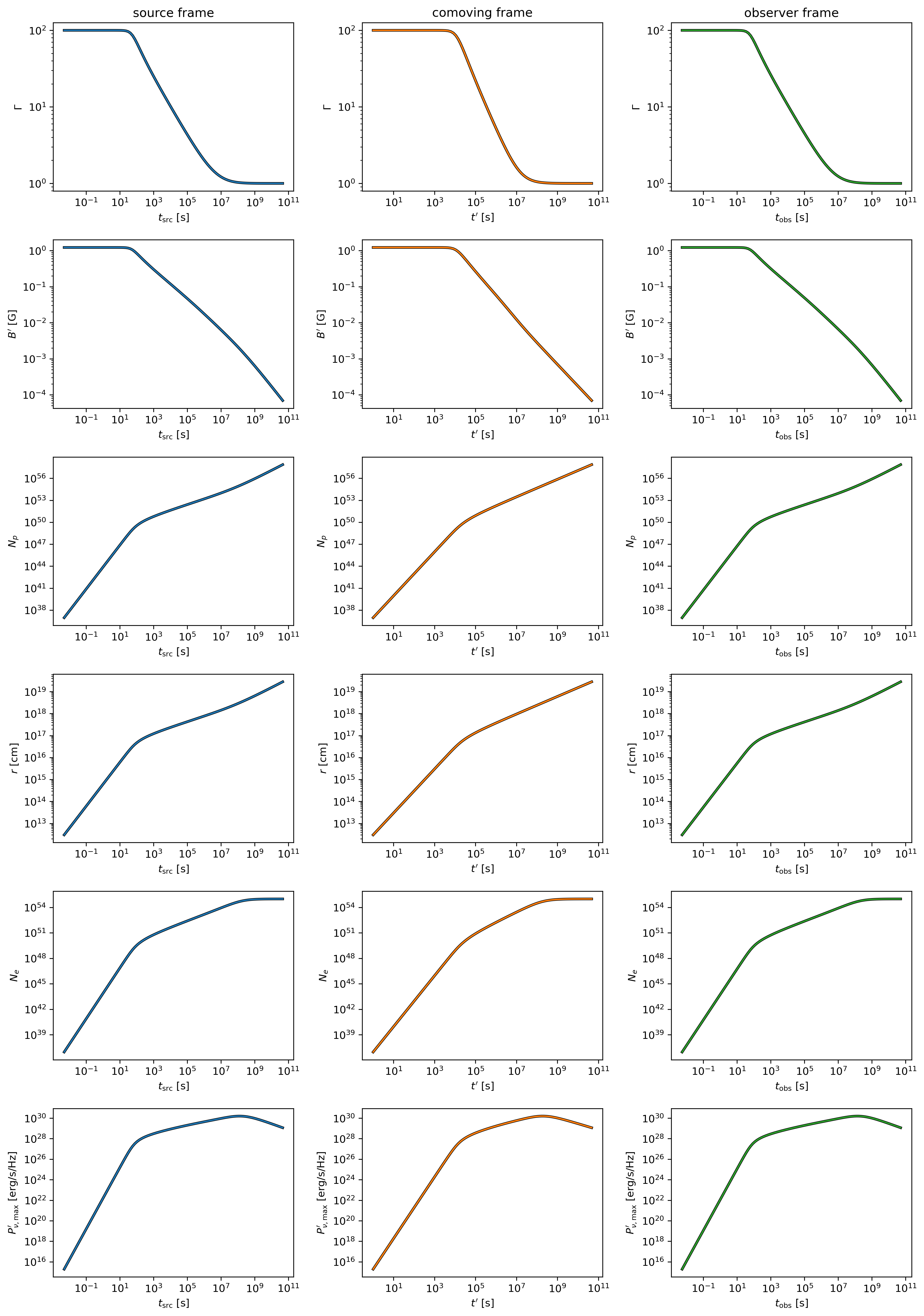
Multi-parameter evolution showing fundamental shock parameters across three reference frames.
Electron Energy Distribution Analysis
This visualization focuses specifically on the characteristic electron energies (self-absorption, injection, and cooling) in both the comoving frame and observer frame, illustrating the relativistic transformation effects:
frames = ['t_src', 't_comv', 't_obs']
xlabels = [r'$t_{\rm src}$ [s]', r'$t^\prime$ [s]', r'$t_{\rm obs}$ [s]']
plt.figure(figsize= (4.2*len(frames), 3.6))
for i, frame in enumerate(frames):
plt.subplot(1, len(frames), i + 1)
if frame == 't_src':
t = getattr(details, frame)
else:
t = getattr(details.fwd, frame)
plt.loglog(t[0, 0, :], details.fwd.gamma_a[0, 0, :],label=r'$\gamma_a^\prime$',c='firebrick')
plt.loglog(t[0, 0, :], details.fwd.gamma_m[0, 0, :],label=r'$\gamma_m^\prime$',c='yellowgreen')
plt.loglog(t[0, 0, :], details.fwd.gamma_c[0, 0, :],label=r'$\gamma_c^\prime$',c='royalblue')
plt.loglog(t[0, 0, :], details.fwd.gamma_a[0, 0, :]*details.fwd.Doppler[0,0,:],label=r'$\gamma_a$',ls='--',c='firebrick')
plt.loglog(t[0, 0, :], details.fwd.gamma_m[0, 0, :]*details.fwd.Doppler[0,0,:],label=r'$\gamma_m$',ls='--',c='yellowgreen')
plt.loglog(t[0, 0, :], details.fwd.gamma_c[0, 0, :]*details.fwd.Doppler[0,0,:],label=r'$\gamma_c$',ls='--',c='royalblue')
plt.xlabel(xlabels[i])
plt.ylabel(r'$\gamma_e^\prime$')
plt.legend(ncol=2)
plt.tight_layout()
plt.savefig('electron_quantities.png', dpi=300,bbox_inches='tight')

Evolution of characteristic electron energies showing relativistic transformation effects.
Synchrotron Frequency Evolution
This analysis tracks the evolution of characteristic synchrotron frequencies, demonstrating how the spectral break frequencies change over time and how Doppler boosting affects the observed spectrum:
frames = ['t_src', 't_comv', 't_obs']
xlabels = [r'$t_{\rm src}$ [s]', r'$t^\prime$ [s]', r'$t_{\rm obs}$ [s]']
plt.figure(figsize= (4.2*len(frames), 3.6))
for i, frame in enumerate(frames):
plt.subplot(1, len(frames), i + 1)
if frame == 't_src':
t = getattr(details, frame)
else:
t = getattr(details.fwd, frame)
plt.loglog(t[0, 0, :], details.fwd.nu_a[0, 0, :],label=r'$\nu_a^\prime$',c='firebrick')
plt.loglog(t[0, 0, :], details.fwd.nu_m[0, 0, :],label=r'$\nu_m^\prime$',c='yellowgreen')
plt.loglog(t[0, 0, :], details.fwd.nu_c[0, 0, :],label=r'$\nu_c^\prime$',c='royalblue')
plt.loglog(t[0, 0, :], details.fwd.nu_a[0, 0, :]*details.fwd.Doppler[0,0,:],label=r'$\nu_a$',ls='--',c='firebrick')
plt.loglog(t[0, 0, :], details.fwd.nu_m[0, 0, :]*details.fwd.Doppler[0,0,:],label=r'$\nu_m$',ls='--',c='yellowgreen')
plt.loglog(t[0, 0, :], details.fwd.nu_c[0, 0, :]*details.fwd.Doppler[0,0,:],label=r'$\nu_c$',ls='--',c='royalblue')
plt.xlabel(xlabels[i])
plt.ylabel(r'$\nu$ [Hz]')
plt.legend(ncol=2)
plt.tight_layout()
plt.savefig('photon_quantities.png', dpi=300,bbox_inches='tight')

Evolution of characteristic synchrotron frequencies showing spectral break evolution and Doppler effects.
Doppler Factor Spatial Distribution
This polar plot visualizes the spatial distribution of the Doppler factor across the jet structure, showing how relativistic beaming varies with angular position and radial distance:
plt.figure(figsize=(6,6))
ax = plt.subplot(111, polar=True)
theta = details.fwd.theta[0,:,:]
r = details.fwd.r[0,:,:]
D = details.fwd.Doppler[0,:,:]
# Polar contour plot
scale = 3.0
c = ax.contourf(theta*scale, r, np.log10(D), levels=30, cmap='viridis')
ax.set_rscale('log')
true_ticks = np.linspace(0, 0.3, 6)
ax.set_xticks(true_ticks * scale)
ax.set_xticklabels([f"{t:.2f}" for t in true_ticks])
ax.set_xlim(0,0.3*scale)
ax.set_ylabel(r'$\theta$ [rad]')
ax.set_xlabel(r'$r$ [cm]')
plt.colorbar(c, ax=ax, label=r'$\log_{10} D$')
plt.tight_layout()
plt.savefig('doppler.png', dpi=300,bbox_inches='tight')
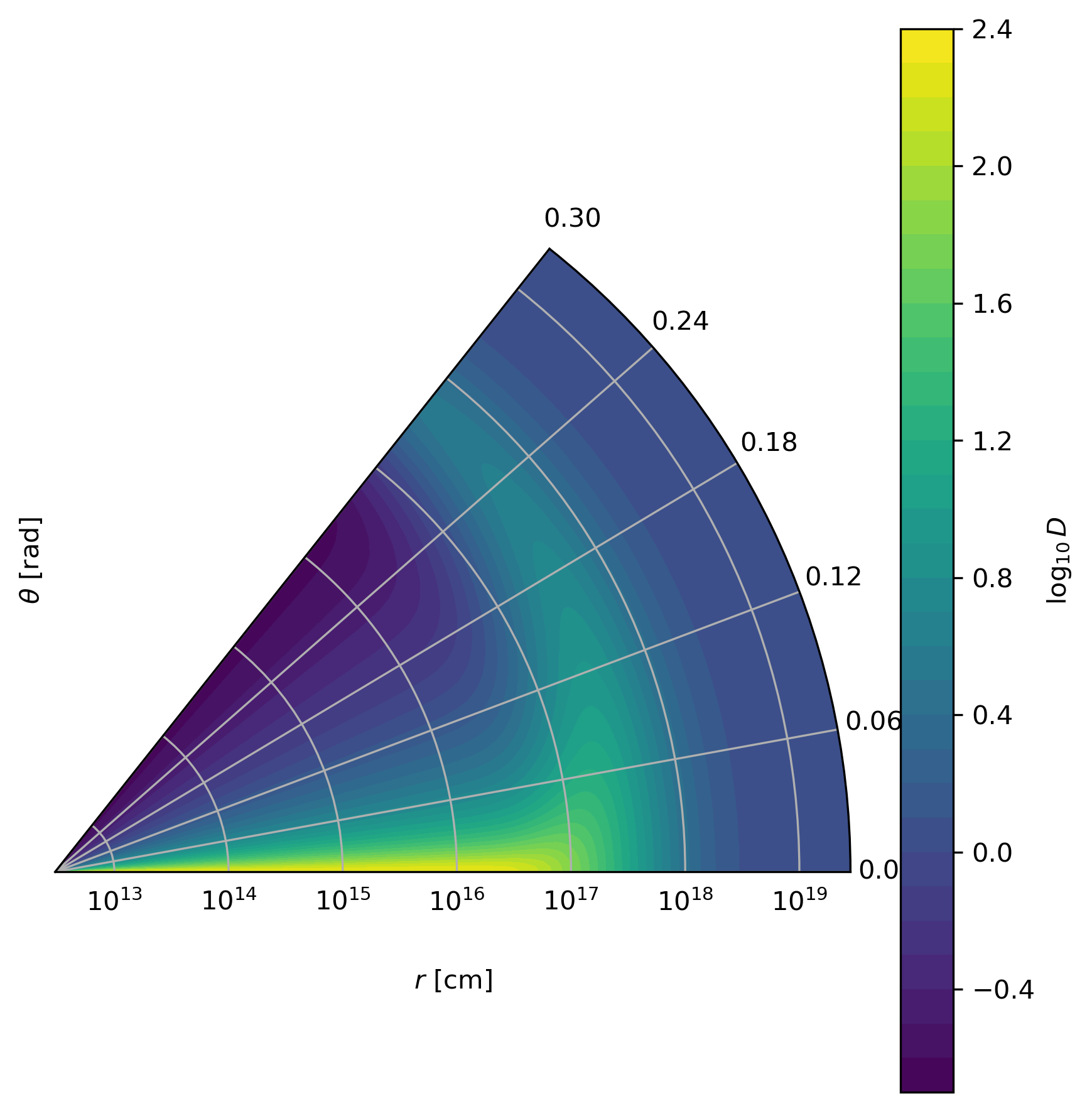
Spatial distribution of Doppler factor showing relativistic beaming effects across the jet structure.
Equal Arrival Time Surface Visualization
This final visualization maps the equal arrival time surfaces in polar coordinates, illustrating how light from different parts of the jet reaches the observer at the same time, which is crucial for understanding light curve morphology:
plt.figure(figsize=(6,6))
ax = plt.subplot(111, polar=True)
theta = details.fwd.theta[0,:,:]
r = details.fwd.r[0,:,:]
t_obs = details.fwd.t_obs[0,:,:]
scale = 3.0
c = ax.contourf(theta*scale, r, np.log10(t_obs), levels=30, cmap='viridis')
ax.set_rscale('log')
true_ticks = np.linspace(0, 0.3, 6)
ax.set_xticks(true_ticks * scale)
ax.set_xticklabels([f"{t:.2f}" for t in true_ticks])
ax.set_xlim(0,0.3*scale)
ax.set_ylabel(r'$\theta$ [rad]')
ax.set_xlabel(r'$r$ [cm]')
plt.colorbar(c, ax=ax, label=r'$\log_{10} (t_{\rm obs}/s)$')
plt.tight_layout()
plt.savefig('EAT.png', dpi=300,bbox_inches='tight')
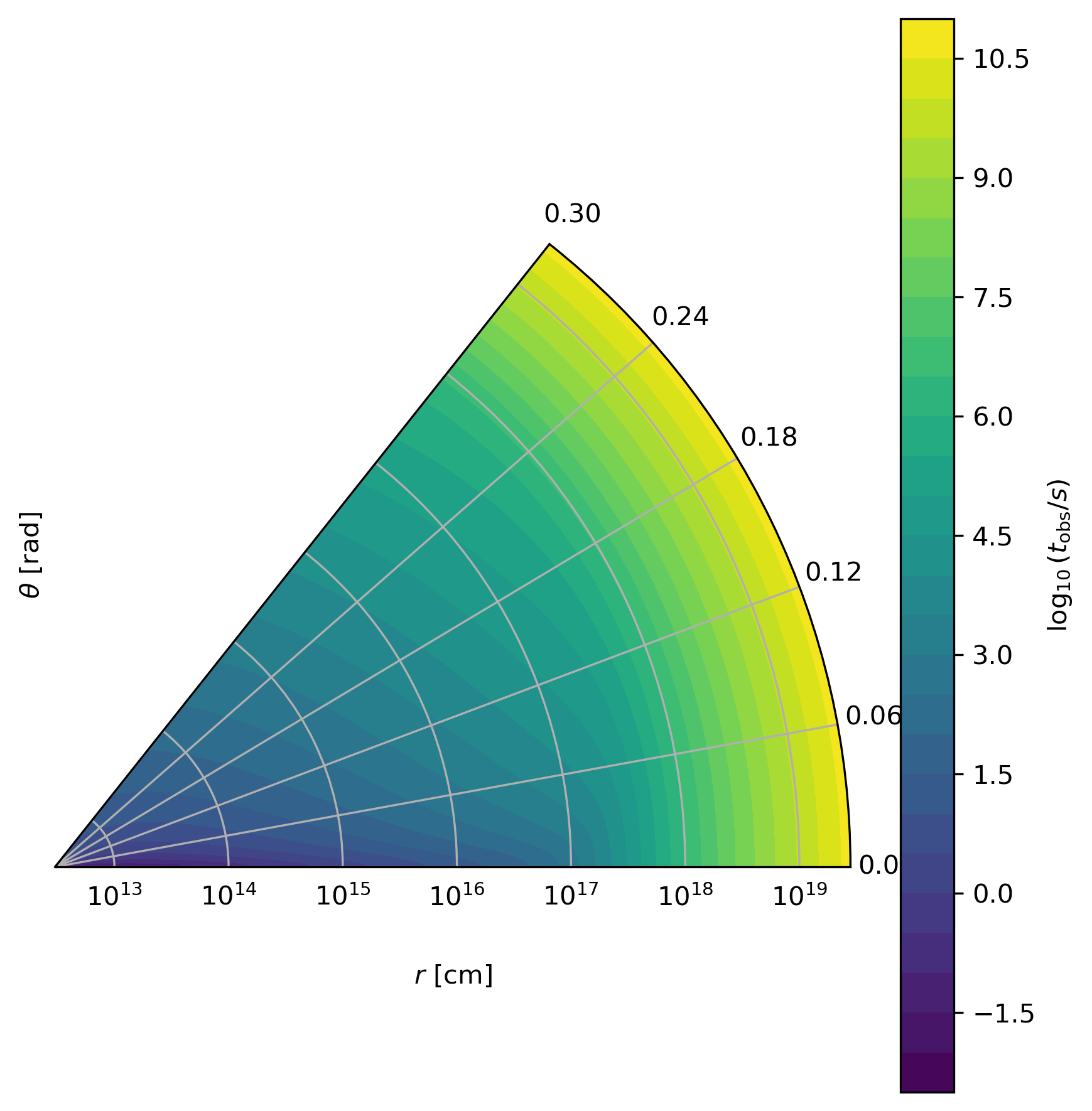
Equal arrival time surfaces showing how light travel time effects determine light curve morphology.
These examples demonstrate VegasAfterglow’s comprehensive capability for analyzing internal quantities and understanding the underlying physics of GRB afterglows. The detailed access to microphysical parameters enables advanced studies of shock dynamics, relativistic effects, and radiation mechanisms across different reference frames.
Model Configuration Introspection
In addition to the details method, VegasAfterglow provides model introspection methods to examine the jet and medium configuration at specific coordinates. These methods are useful for understanding the initial setup and validating model configuration:
import numpy as np
# Define coordinate arrays for introspection
phi = 0.0 # Azimuthal angle [radians]
theta = np.linspace(0, 0.5, 50) # Polar angles [radians]
r = np.logspace(15, 20, 100) # Radii [cm]
# Get jet properties as a function of angle
E_iso_profile = model.jet_E_iso(phi, theta) # Isotropic energy [erg]
Gamma0_profile = model.jet_Gamma0(phi, theta) # Initial Lorentz factor
# Get medium density as a function of position
# Note: r should be a 1D array for the medium method
rho_profile = model.medium(phi, theta[0], r) # Density [g/cm³]
# Visualize the jet structure
plt.figure(figsize=(12, 4))
# Plot jet energy profile
plt.subplot(1, 3, 1)
plt.plot(theta, E_iso_profile)
plt.xlabel(r'$\theta$ [rad]')
plt.ylabel(r'$E_{\rm iso}$ [erg]')
plt.title('Jet Energy Profile')
plt.yscale('log')
# Plot jet Lorentz factor profile
plt.subplot(1, 3, 2)
plt.plot(theta, Gamma0_profile)
plt.xlabel(r'$\theta$ [rad]')
plt.ylabel(r'$\Gamma_0$')
plt.title('Jet Lorentz Factor Profile')
plt.yscale('log')
# Plot medium density profile
plt.subplot(1, 3, 3)
plt.loglog(r, rho_profile)
plt.xlabel(r'$r$ [cm]')
plt.ylabel(r'$\rho$ [g/cm³]')
plt.title('Medium Density Profile')
plt.tight_layout()
plt.show()
Available model introspection methods:
model.jet_E_iso(phi, theta): Returns the isotropic energy distribution [erg] as a function of azimuthal anglephi[rad] and polar angletheta[rad]model.jet_Gamma0(phi, theta): Returns the initial Lorentz factor distribution as a function of azimuthal anglephi[rad] and polar angletheta[rad]model.medium(phi, theta, r): Returns the medium density [g/cm³] as a function of azimuthal anglephi[rad], polar angletheta[rad], and radiusr[cm]
These methods enable detailed analysis of the model configuration and are particularly useful for:
Validating jet structure parameters
Understanding the angular dependence of jet properties
Analyzing medium density profiles
Creating publication-quality plots of model setup
Debugging complex multi-component jet configurations
Parameter Estimation with MCMC
For more advanced analysis, VegasAfterglow provides powerful MCMC capabilities to fit model parameters to observational data.
First, let’s import the necessary modules:
import numpy as np
import matplotlib.pyplot as plt
import pandas as pd
import corner
from VegasAfterglow import ObsData, Setups, Fitter, ParamDef, Scale
Preparing Data and Configuring the Model
VegasAfterglow provides flexible options for loading observational data through the ObsData class. You can add light curves (specific flux vs. time) and spectra (specific flux vs. frequency) in multiple ways:
# Create an instance to store observational data
data = ObsData()
# Method 1: Add data directly from lists or numpy arrays
# For light curves
t_data = [1e3, 2e3, 5e3, 1e4, 2e4] # Time in seconds
flux_data = [1e-26, 8e-27, 5e-27, 3e-27, 2e-27] # Specific flux in erg/cm²/s/Hz
flux_err = [1e-28, 8e-28, 5e-28, 3e-28, 2e-28] # Specific flux error in erg/cm²/s/Hz
data.add_flux_density(nu=4.84e14, t=t_data, f_nu=flux_data, err=flux_err) # All quantities in CGS units
# You can also assign weights to each data point to account for systematic uncertainties or correlations. You don't need to worry about the weights' normalization, the code will normalize them automatically.
#data.add_flux_density(nu=4.84e14, t=t_data, f_nu=flux_data, err=flux_err, weights=np.ones(len(t_data)))
# For spectra
nu_data = [...] # Frequencies in Hz
spectrum_data = [...] # Specific flux values in erg/cm²/s/Hz
spectrum_err = [...] # Specific flux errors in erg/cm²/s/Hz
data.add_spectrum(t=3000, nu=nu_data, f_nu=spectrum_data, err=spectrum_err) # All quantities in CGS units
# Method 2: Load from CSV files
data = ObsData()
# Define your bands and files
bands = [2.4e17, 4.84e14, 1.4e14] # Example: X-ray, optical R-band
lc_files = ["data/ep.csv", "data/r.csv", "data/vt-r.csv"]
# Load light curves from files
for nu, fname in zip(bands, lc_files):
df = pd.read_csv(fname)
data.add_flux_density(nu=nu, t=df["t"], f_nu=df["Fv_obs"], err=df["Fv_err"]) # All quantities in CGS units
times = [3000] # Example: time in seconds
spec_files = ["data/ep-spec.csv"]
# Load spectra from files
for t, fname in zip(times, spec_files):
df = pd.read_csv(fname)
data.add_spectrum(t=t, nu=df["nu"], f_nu=df["Fv_obs"], err=df["Fv_err"]) # All quantities in CGS units
Note
The ObsData interface is designed to be flexible. You can mix and match different data sources, and add multiple light curves at different frequencies as well as multiple spectra at different times.
The Setups class defines the global properties and environment for your model. These settings remain fixed during the MCMC process:
cfg = Setups()
# Source properties
cfg.lumi_dist = 3.364e28 # Luminosity distance [cm]
cfg.z = 1.58 # Redshift
# Physical model configuration
cfg.medium = "wind"
cfg.jet = "powerlaw"
These settings affect how the model is calculated but are not varied during the MCMC process.
Defining Parameters and Running MCMC
The ParamDef class is used to define the parameters for MCMC exploration. Each parameter requires a name, prior range, and sampling scale:
mc_params = [
ParamDef("E_iso", 1e50, 1e54, Scale.LOG), # Isotropic energy [erg]
ParamDef("Gamma0", 5, 1000, Scale.LOG), # Lorentz factor at the core
ParamDef("theta_c", 0.0, 0.5, Scale.LINEAR), # Core half-opening angle [rad]
ParamDef("k_e", 2, 2, Scale.FIXED), # Energy power law index
ParamDef("k_g", 2, 2, Scale.FIXED), # Lorentz factor power law index
ParamDef("theta_v", 0.0, 0.0, Scale.FIXED), # Viewing angle [rad]
ParamDef("p", 2, 3, Scale.LINEAR), # Shocked electron power law index
ParamDef("eps_e", 1e-2, 0.5, Scale.LOG), # Electron energy fraction
ParamDef("eps_B", 1e-4, 0.5, Scale.LOG), # Magnetic field energy fraction
ParamDef("A_star", 1e-3, 1, Scale.LOG), # Wind parameter
ParamDef("xi_e", 1e-3, 1, Scale.LOG), # Electron acceleration fraction
]
- Scale Types:
Scale.LOG: Sample in logarithmic space (log10) - ideal for parameters spanning multiple orders of magnitudeScale.LINEAR: Sample in linear space - appropriate for parameters with narrower rangesScale.FIXED: Keep parameter fixed at the initial value - use for parameters you don’t want to vary
Parameter Choices: The parameters you include depend on your model configuration:
For “wind” medium: use
A_starparameterFor “ISM” medium: use
n_ismparameter insteadDifferent jet structures may require different parameters
Initialize the Fitter class with your data and configuration, then run the MCMC process:
# Create the fitter object
fitter = Fitter(data, cfg)
# Option 1: MCMC with emcee (faster, recommended for quick fitting)
result = fitter.fit(
mc_params,
resolution=(0.3, 1, 10), # Grid resolution (phi, theta, t)
sampler="emcee", # MCMC sampler
nsteps=10000, # Number of steps per walker
nburn=1000, # Burn-in steps to discard
thin=1, # Save every nth sample
npool=8, # Number of parallel processes
top_k=10, # Number of best-fit parameters to return
outdir="bilby_output", # Output directory (default)
label="afterglow_fit", # Run label (default: "afterglow")
)
# Option 2: Nested sampling with dynesty (slower but computes Bayesian evidence)
result = fitter.fit(
mc_params,
resolution=(0.3, 1, 10), # Grid resolution (phi, theta, t)
sampler="dynesty", # Nested sampling algorithm
nlive=500, # Number of live points
dlogz=0.1, # Stopping criterion (evidence tolerance)
sample="rwalk", # Sampling method
npool=8, # Number of parallel processes
top_k=10, # Number of best-fit parameters to return
)
- Important Notes:
Parameters with
Scale.LOGare sampled aslog10_<name>(e.g.,log10_E_iso)The sampler works in log10 space for LOG-scale parameters, then transforms back
Use
npoolto parallelize likelihood evaluations across multiple CPU cores
- The
resultobject contains: samples: The posterior samples (shape: [n_samples, 1, n_params])labels: Parameter names (withlog10_prefix for LOG-scale params)latex_labels: LaTeX-formatted labels for plotting (e.g.,$\log_{10}(E_{\rm iso})$)top_k_params: Top-k maximum likelihood parameter valuestop_k_log_probs: Log probabilities for top-k samplesbilby_result: Full bilby Result object (for advanced diagnostics)
Analyzing Results and Generating Predictions
Check the best-fit parameters and their uncertainties:
top_k_data = []
for i in range(result.top_k_params.shape[0]):
row = {'Rank': i+1, 'chi^2': f"{-2*result.top_k_log_probs[i]:.2f}"}
for name, val in zip(result.labels, result.top_k_params[i]):
row[name] = f"{val:.4f}"
top_k_data.append(row)
top_k_df = pd.DataFrame(top_k_data)
print("Top-k parameters:")
print(top_k_df.to_string(index=False))
Use the best-fit parameters to generate model predictions:
# Define time and frequency ranges for predictions
t_out = np.logspace(2, 9, 150)
bands = [2.4e17, 4.84e14, 1.4e14]
# Generate light curves with the best-fit model
lc_best = fitter.flux_density_grid(result.top_k_params[0], t_out, bands)
nu_out = np.logspace(6, 20, 150)
times = [3000]
# Generate model spectra at the specified times using the best-fit parameters
spec_best = fitter.flux_density_grid(result.top_k_params[0], times, nu_out)
Now you can plot the best-fit model:
def draw_bestfit(t, lc_fit, nu, spec_fit):
# Create figure with two subplots
fig, (ax1, ax2) = plt.subplots(2, 1, figsize=(4.5, 7.5))
# Plot light curves
shifts = [1, 1, 200]
colors = ['blue', 'orange', 'green']
for i in range(len(lc_files)):
df = pd.read_csv(lc_files[i])
ax1.errorbar(df["t"], df["Fv_obs"] * shifts[i], df["Fv_err"] * shifts[i],
fmt='o', color=colors[i], label=lc_files[i])
ax1.plot(t, np.array(lc_fit[i]) * shifts[i], color=colors[i], lw=1)
# Plot spectra
for i in range(len(spec_files)):
df = pd.read_csv(spec_files[i])
ax2.errorbar(df["nu"], df["Fv_obs"] * shifts[i], df["Fv_err"] * shifts[i],
fmt='o', color=colors[i], label=spec_files[i])
ax2.plot(nu, np.array(spec_fit[0]) * shifts[i], color=colors[i], lw=1)
# Configure axes
for ax, xlabel, ylabel in [(ax1, 't [s]', r'$F_\nu$ [erg/cm$^2$/s/Hz]'),
(ax2, r'$\nu$ [Hz]', r'$F_\nu$ [erg/cm$^2$/s/Hz]')]:
ax.set_xscale('log'); ax.set_yscale('log')
ax.set_xlabel(xlabel); ax.set_ylabel(ylabel)
ax.legend()
plt.tight_layout()
draw_bestfit(t_out, lc_best, nu_out, spec_best)
Corner plots are essential for visualizing parameter correlations and posterior distributions:
def plot_corner(flat_chain, labels, filename="corner_plot.png"):
fig = corner.corner(
flat_chain,
labels=labels,
quantiles=[0.16, 0.5, 0.84], # For median and ±1σ
show_titles=True,
title_kwargs={"fontsize": 14},
label_kwargs={"fontsize": 14},
truths=np.median(flat_chain, axis=0), # Show median values
truth_color='red',
bins=30,
smooth=1,
fill_contours=True,
levels=[0.16, 0.5, 0.68], # 1σ and 2σ contours
color='k'
)
fig.savefig(filename, dpi=300, bbox_inches='tight')
# Create the corner plot
flat_chain = result.samples.reshape(-1, result.samples.shape[-1])
plot_corner(flat_chain, result.latex_labels)
Next Steps
See the Examples page for more detailed examples
Check the Parameter Reference for comprehensive parameter documentation
Visit the Troubleshooting page if you encounter any issues